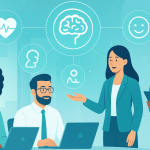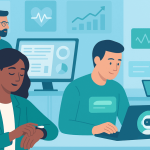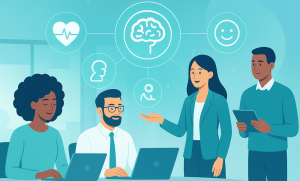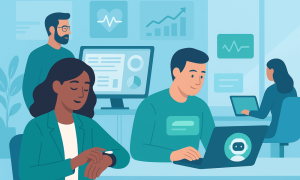The modern workplace is fast-paced, always connected, and mentally demanding. Employees often find themselves glued to their screens for hours without realizing the toll it takes on their health. Research shows that prolonged focus without breaks leads to higher stress levels, fatigue, and eventually burnout. This is where AI-powered micro-break prompts are becoming a game-changer, reminding workers to pause, recharge, and reset before stress escalates.
By blending intelligent reminders with personalized wellness guidance, organizations can transform how employees manage their energy and mental well-being. Let’s explore how this innovation works and why it is vital for healthier workplaces.
What Are Micro-Break Prompts?
Micro-break prompts are gentle nudges designed to remind employees to take short, intentional pauses throughout the day. Unlike long breaks or lunch hours, these micro-moments may last only a few minutes but can significantly reduce stress and enhance focus.
With AI coaching for stress management, these prompts are no longer generic. Instead, they are adaptive, data-driven, and context-aware—helping individuals reset in the most effective way possible.
Why Micro-Breaks Matter for Mental Well-Being
Skipping breaks may seem like an attempt to increase productivity, but the opposite is true. When the brain is overworked, decision-making quality decreases, errors rise, and creativity suffers.
Micro-breaks provide:
- Cognitive refresh: Short pauses restore focus and prevent mental fatigue.
- Physical relief: Movement reduces tension from prolonged sitting.
- Stress reduction: Breathing or mindfulness exercises lower cortisol levels.
- Emotional balance: Moments of calm help employees regulate mood and anxiety.
When guided by AI, these micro-breaks align with an employee’s stress signals, work intensity, and wellness goals.
How AI Powers Micro-Break Prompts
AI is reshaping how workplaces approach wellness. By analyzing data such as typing speed, meeting loads, and even biometric signals (if employees opt-in), AI can detect stress patterns and recommend timely breaks.
Here’s how it works:
- Real-time monitoring – AI observes activity levels and detects signs of fatigue or stress.
- Personalized prompts – Instead of a one-size-fits-all reminder, the system tailors suggestions to individual needs.
- Interactive coaching – Platforms like Coach Nova provide guided breathing, short meditations, or motivational nudges.
- Seamless integration – Break prompts appear in existing workplace tools like Slack, Teams, or email.
- Wellness analytics – AI tracks progress over time, helping leaders measure organizational well-being.
This proactive approach ensures that stress relief is not left to chance but embedded directly into the workday.
Practical Examples of AI-Powered Micro-Break Prompts
AI-driven platforms deliver micro-break prompts in engaging ways. Some examples include:
- Stretch reminders with guided animations.
- Mindful breathing exercises triggered after long focus sessions.
- Digital detox nudges when excessive screen time is detected.
- Hydration and posture prompts for physical well-being.
- Mood check-ins encouraging emotional self-awareness.
These interventions not only improve well-being but also foster a culture where taking breaks is seen as a strength, not a weakness.
Benefits for Organizations
Companies adopting AI-powered stress relief tools experience measurable benefits:
- Reduced absenteeism – Proactive stress management lowers sick leave.
- Higher productivity – Employees return from micro-breaks sharper and more engaged.
- Improved morale – Teams feel supported and valued.
- Lower burnout rates – Preventive action stops exhaustion before it spirals.
- Better retention – Employees stay longer when their well-being is prioritized.
This aligns with the growing emphasis on AI mental wellbeing solutions in corporate environments.
The Role of AI in Personalized Wellness
Unlike traditional workplace wellness programs, AI adapts to each employee’s unique rhythm. For example, someone working in back-to-back meetings may get short grounding prompts, while a software engineer coding for hours may receive posture and stretch reminders.
This personalization creates a sense of care and relevance, encouraging employees to actually follow through on break prompts.
Overcoming Resistance to Taking Breaks
Some employees resist micro-breaks because they fear looking unproductive or falling behind. AI helps by normalizing wellness culture across organizations. When everyone receives prompts, it signals that self-care is a shared priority, not an individual weakness.
Additionally, by embedding AI solution for stress into workflows, employees don’t have to remember to take care of themselves the system does it for them.
Industry Relevance: Stress Relief for High-Pressure Sectors
Industries like construction, mining, and healthcare face unique stress challenges due to long shifts and physically demanding work. AI-powered micro-breaks can be customized for these contexts:
- Healthcare workers may get quick mindfulness prompts between patient visits.
- Construction teams can benefit from hydration and micro-movement reminders.
- Remote employees can use guided stretches to reduce digital fatigue.
This flexibility makes AI-driven micro-break solutions highly valuable across different industries.
Future of Micro-Break Technology
The next evolution of micro-break prompts will include:
- Wearable integration: Smartwatches tracking heart rate and stress to trigger breaks.
- Voice-based nudges: AI assistants encouraging short wellness activities.
- Gamified wellness: Teams earning rewards for consistent break habits.
- Predictive analytics: Anticipating burnout risk and intervening early.
Conclusion
Micro-breaks may sound small, but when guided by AI they become powerful tools for preventing stress and burnout at work. With AI-powered stress relief prompts, employees can maintain focus, protect their mental health, and work more sustainably. For organizations, this shift means stronger performance, higher retention, and a workplace culture that truly values well-being.
The future of work is not about pushing harder, it’s about working smarter with the right support systems in place. AI is making that future possible, one micro-break at a time.







